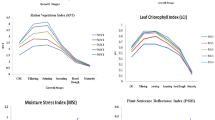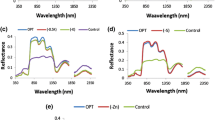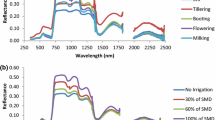Abstract
Drought is one of the main limiting factors of soybean production. The great deal of time and effort that current available phenotyping methods demand hampers the selection of tolerant genotypes. Therefore, the development of techniques capable of determining the water status of plants in a fast and practical way may improve the ability to distinguish genotypes under water deficit conditions. The aim of this study was to correlate physiological variables such as relative water content and gas exchange measurements, with vegetation indices (VIs) and spectral bands in order to optimize tools for plant phenotyping. Two trials were carried out, one in a climatic chamber and one in the field. The soybean genotypes were submitted to water deficit and control (irrigated) conditions. The variables measured were relative water content, leaf temperature, photosynthesis, transpiration, stomatal conductance and internal CO2 content. The VIs NDWI(1000–1600), NDWI(1000–2300), NMDI, MSI and the spectral bands SWIR1600, SWIR2300, ρ1440, ρ1920, ρ1440+ρ1920, ρ1920−ρ1440 and SWIR−ρ1440 were obtained using a hyperspectral sensor. According to the results, the physiological measurements, the VIs and the spectral bands were able to differentiate the water conditions to which the genotypes were submitted and, in some cases, the indices and bands were more sensitive than the physiological measures to detect genotype effect. All indices and bands were efficient in determining the water status of soybean plants. However, the SWIR indices were the most sensitive, allowing the differentiation of a greater number of genotypes with high accuracy.







Similar content being viewed by others
References
Blake, G. R., & Hartge, K. H. (1986). Bulk Density. Methods of Soil Analysis—Part 1: Physical and Mineralogical Methods, 363–75. Madison, WI, USA: American Society of Agronomy-Soil Science Society of America.
Campos, I., Neale, C. M., Suyker, A. E., Arkebauer, T. J., & Gonçalves, I. Z. (2017). Reflectance-based crop coefficients REDUX: For operational evapotranspiration estimates in the age of high producing hybrid varieties. Agricultural Water Management, 187, 140–153.
Chen, D., Huang, J., & Jackson, T. J. (2005). Vegetation water content estimation for corn and soybeans using spectral indices derived from MODIS near- and short-wave infrared bands. Remote Sensing of Environment, 98(2–3), 225–236. https://doi.org/10.1016/j.rse.2005.07.008.
Chowdhury, J. A., Karim, M. A., Khaliq, Q. A., Ahmed, A. U., & Mondol, A. M. (2017). Effect of drought stress on water relation traits of four soybean genotypes. SAARC Journal of Agriculture, 15(2), 163–175.
CONAB—Companhia Nacional de Abastecimento. (2018). Acompanhamento Da Safra Brasileira De Grãos Safra 2017/18—Décimo Primeiro Levantamento (Monitoring of the Brazilian Grain Harvest 2017/18 Harvest - Eleventh Survey). ISSN 2318-6852.
Crusiol, L. G. T., Carvalho, J. F. C., Sibaldelli, R. N. R., Neiverth, W., do Rio, A., Ferreira, L. C., et al. (2017). NDVI variation according to the time of measurement, sampling size, positioning of sensor and water regime in different soybean cultivars. Precision Agriculture, 18(4), 470–490. https://doi.org/10.1007/s11119-016-9465-6.
Fehr, W. R., Caviness, C. E., Burmood, D. T., & Pennington, J. S. (1971). Stage of development description for soybeans, Glycine max (L.) Merrill. Crop Science, 11, 929–931. https://doi.org/10.2135/cropsci1971.0011183X001100060051x.
Ferreira, R. C. (2016). Quantificação das perdas por seca na cultura da soja no Brasil (Quantification of drought losses in soybean crop in Brazil). 102f. Tese (Doutorado em Agronomia). Universidade Estadual de Londrina, Londrina, Brazil.
Fleury, D., Jefferies, S., Kuchel, H., & Langridge, P. (2010). Genetic and genomic tools to improve drought tolerance in wheat. Journal of Experimental Botany, 61(12), 3211–3222.
Flexas, J., Bota, J., Loreto, F., Cornic, G., & Sharkey, T. D. (2004). Diffusive and metabolic limitations to photosynthesis under drought and salinity in C3 plants. Plant Biology, 6(3), 269–279. https://doi.org/10.1055/s-2004-820867.
Gao, B. C. (1996). NDWI—A normalized difference water index for remote sensing of vegetation liquid water from space. Remote sensing of environment, 58(3), 257–266.
Giordani, W., Goncalves, L. S. A., Moraes, L. A. C., Ferreira, L. C., Neumaier, N., Farias, J. R. B., et al. (2019). Identification of agronomical and morphological traits contributing to drought stress tolerance in soybean. Australian Journal of Crop Science, 13(1), 35.
Hiraruki, M. H. (2014). Impactos Econômicos de Estresses Bióticos e Abióticos Na Produção de Soja (Economic impacts of biotic and abiotic stresses on soybean production). Embrapa Soja —ircular Técnica (INFOTECA-E) 105: 1–8.
Honna, P. T., Fuganti-Pagliarini, R., Ferreira, L. C., Molinari, M. D. C., de Marin, S. R. R., Oliveira, M., et al. (2016). Molecular, physiological, and agronomical characterization, in greenhouse and in field conditions, of soybean plants genetically modified with AtGolS2 gene for drought tolerance. Molecular Breeding, 36(11), 157. https://doi.org/10.1007/s11032-016-0570-z.
Hunt Jr, E. R., Friedman, J., Cosh, M., Li, L., Gaiser, P., & Twarog, E. (2017). Vegetation water content of crops and woodlands for improving soil moisture retrievals from coriolis Windsat. Fairfax, USA: IEEE, pp. 1–5, https://doi.org/10.1109/Agro-Geoinformatics.2017.8047025.
Hunt, E. R., Jr., & Rock, B. N. (1989). Detection of changes in leaf water content using near- and middle-infrared reflectances. Remote Sensing of Environment, 30(1), 43–54. https://doi.org/10.1016/0034-4257(89)90046-1.
Inoue, Y., Morinaga, S., & Shibayama, M. (1993). Non-destructive estimation of water status of intact crop leaves based on spectral reflectance measurements. Japanese Journal of Crop Science, 62(3), 462–469. https://doi.org/10.1626/jcs.62.462.
Kaler, A. S., Ray, J. D., Schapaugh, W. T., King, C. A., & Purcell, L. C. (2017). Genome-wide association mapping of canopy wilting in diverse soybean genotypes. Theoretical and Applied Genetics, 130(10), 2203–2217. https://doi.org/10.1007/s00122-017-2951-z.
Kiriga, W. J., Yu, Q., & Bill, R. (2016). Breeding and genetic engineering of drought-resistant crops. International Journal of Agriculture and Crop Sciences, 9, 7–12.
Manavalan, L. P., Guttikonda, S. K., Tran, L. S. P., & Nguyen, H. T. (2009). Physiological and molecular approaches to improve drought resistance in soybean. Plant and Cell Physiology, 50(7), 1260–1276. https://doi.org/10.1093/pcp/pcp082.
Marinho, J. P., Kanamori, N., Ferreira, L. C., Fuganti-Pagliarini, R., Carvalho, J. F. C., Freitas, R. A., et al. (2016). Characterization of molecular and physiological responses under water deficit of genetically modified soybean plants overexpressing the AtAREB1 Transcription Factor. Plant Molecular Biology Reporter, 34(2), 410–426. https://doi.org/10.1007/s11105-015-0928-0.
Mertz-Henning, L., Ferreira, L., Henning, F., Mandarino, J., Santos, E., Oliveira, M., et al. (2017). Effect of water deficit-induced at vegetative and reproductive stages on protein and oil content in soybean grains. Agronomy, 8(1), 3. https://doi.org/10.3390/agronomy8010003.
Oya, T., Nepomuceno, A. L., Neumaier, N., Farias, J. R. B., Tobita, S., & Ito, O. (2004). Drought tolerance characteristics of Brazilian soybean cultivars—Evaluation and characterization of drought tolerance of various Brazilian soybean cultivars in the field. Plant Production Science, 7(2), 129–137. https://doi.org/10.1626/pps.7.129.
Richetti, J., Boote, K. J., Hoogenboom, G., Judge, J., Johann, J. A., & Uribe-Opazo, M. A. (2019). Remotely sensed vegetation index and LAI for parameter determination of the CSM-CROPGRO-Soybean model when in situ data are not available. International Journal of Applied Earth Observation and Geoinformation, 79, 110–115.
Rouse, J. W., Haas, R. H., Schell, J. A., & Deering, D. W. (1974). Monitoring vegetation systems in the Great Plains with ERTS. NASA Special Publication, 351, 309.
Schonfeld, M. A., Johnson, R. C., Carver, B. F., & Mornhinweg, D. W. (1988). Water relations in winter wheat as drought resistance indicators. Crop Science, 28(3), 526. https://doi.org/10.2135/cropsci1988.0011183X002800030021x.
Seo, B., Lee, J., Lee, K. D., Hong, S., & Kang, S. (2019). Improving remotely-sensed crop monitoring by NDVI-based crop phenology estimators for corn and soybeans in Iowa and Illinois, USA. Field Crops Research, 238, 113–128.
USDA—United States Departmant of Agriculture. (2018). Oilseeds: World Markets and Trade.
Wang, L., & Qu, J. J. (2007). NMDI: A normalized multi-band drought index for monitoring soil and vegetation moisture with satellite remote sensing. Geophysical Research Letters, 34(20), 1–5. https://doi.org/10.1029/2007GL031021.
Zhang, D., & Zhou, G. (2016). Estimation of soil moisture from optical and thermal remote sensing: A review. Sensors, 16(8), 1308.
Author information
Authors and Affiliations
Corresponding authors
Additional information
Publisher's Note
Springer Nature remains neutral with regard to jurisdictional claims in published maps and institutional affiliations.
Rights and permissions
About this article
Cite this article
Braga, P., Crusiol, L.G.T., Nanni, M.R. et al. Vegetation indices and NIR-SWIR spectral bands as a phenotyping tool for water status determination in soybean. Precision Agric 22, 249–266 (2021). https://doi.org/10.1007/s11119-020-09740-4
Published:
Issue Date:
DOI: https://doi.org/10.1007/s11119-020-09740-4




